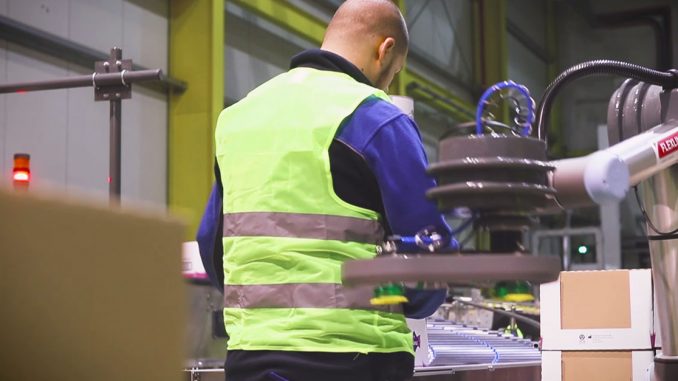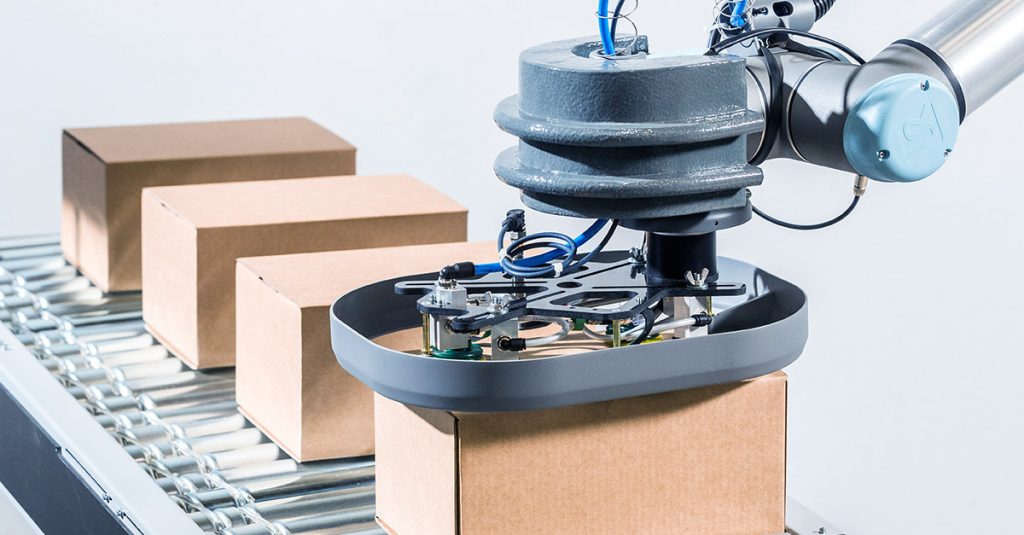
Do you remember our blog article “Cobot – A new way to automate production flows”? Since that article was written, collaborative robots (cobots) have developed significantly. More advanced safety solutions, expanded operation capacity, and smarter design are just a few of the changes that have improved the cobots. It is definitely a development worth following when operating in the manufacturing industry.
Collaborative robot – a robot that cooperates with humans
A collaborative robot, or a cobot, can be defined as a robot that intends to physically interact and cooperate with humans in a shared workspace. This is in contrast to regular robots that are designed to operate autonomously, or with limited guidance in a closed-off robot cell, which is what most industrial robots did until cobots were introduced over ten years ago.
Cobots are based on a technology that is still fairly new in the manufacturing industry. They were primarily designed to create a smaller and cheaper alternative to the regular industrial robot. Regular robots tend to be complex machines that require a lot of safety measures and complementary features. Cobots, on the other hand, are based on a simpler technology, making them easy to use and without the need to be managed by a software engineer.
Great development with focus on safety
Cobots are used worldwide, across all manufacturing industries. Even though fairly new technology, it has developed very fast during its first few years on the market. Now, we are reaching a technical plateau. In the 2020s, cobots will have to offer even more added value and be able to mimic the human eye, hands, and brain as well as be safe in case of human contact. Therefore, the new generation of cobots and associated solutions are focusing on integrated vision systems, flexible grippers, smarter human interaction, and safety. Cameras are now embedded into the cobot to recognize the products they are handling. The level of sensitivity to stop the cobot is also improving.
Safety scanners – one of the most common safety solutions
A collaborative robot can generally operate in any manufacturing industry. However, it has a lower operating speed compared to a regular robot. This is to avoid potential accidents since it is collaborating with humans. In addition, it has a limitation in how heavy products it can handle. Therefore, it is most suited to work in productions with relatively low loads and speeds, such as the industry of fast moving consumer goods (FMCG).
The main purpose of cobots is to create high efficiency in production and at the same time maintain high quality of the products. It is a flexible solution in the sense that it only takes one person to move a cobot around the production line and place it where it is needed the most. Or, to move it to another production site if needed. Thanks to its more compact dimensions and substantially lower weight it can be an excellent alternative to a regular industrial robot that often is bigger and has more external components. Thus, it is a great choice for production sites that require flexibility and equipment that has a small environmental footprint.
Assists in palletizing, depalletizing as well as pick and place
When the cobots first entered the market, they were designed as robot arms and were quite limited in what type of tasks they could perform. However, during the last few years, the design has developed and expanded the cobots area of use. Today, they can operate together with automatic guided vehicles (AGV) and move around in the factory plant collecting pallets. They can work with palletizing and, for example, package boxes on to a pallet as well as de-palletizing, which means they move a box from a pallet on to a conveyor. They can assist in the procedure called pick and place by packaging products in a box, as well as help with material infeed.
Also, its appearance and way of interacting with humans have had a great development. They can be programmed so they can speak to humans and say, for example, good morning. It is also possible to, for example, play music using programs from the cobot.
High machine capacity and safety with a safety scanner
Different safety solutions have developed over the years, and are still developing. One of the most common safety solutions is a safety scanner. The scanner, or radar, detects when a human comes close to the cobot. At first, when a human enters the cobot’s safety area it slows down the speed. If the human comes even closer, within the cobots reach, it stops moving completely. When the human steps away from the cobot, it resumes its work again. This solution allows the cobot to operate at full capacity when not being disturbed by the surroundings.
There is a general fear that robots will enter the labor market and take over the humans’ jobs. However, this is not the case with collaborative robots. They are designed to help by collaborating with humans and make productions even more efficient, which will save money for the production owner. For example, the cobots can take over tasks in production that in some way can jeopardize humans’ health and safety. This allows humans to focus on tasks that add more value to the production.
FlexLink is at the forefront when it comes to innovative production equipment
The latest trend regarding collaborative robots is that many suppliers offer the possibility to rent or lease a cobot. This way, the production owner can try the solution and see if it fits their specific production without doing a financial investment. In the near future, collaborative robots will also play a valuable role in the shift towards smart factory automation, also known as Industry 4.0. They will be able to provide the staff with information about different machines and, for example, inform about predictive maintenance. Personally, I will not be surprised if advanced development of the cobot that today is considered high-tech and futuristic will be implemented and ready to operate very soon.
Therefore, it is very important for us, as a provider of smart production equipment, to be at the forefront when it comes to new and innovative production flow solutions. We, at FlexLink, offer a variety of different robotic solutions. We work hard to provide our customers with the latest and most updated production solutions to help create an effective and well-functioning production in the manufacturing industry.
I hope you enjoyed reading my blog article about collaborative robots and how technology has developed during the last few years. Feel free to contact me with any questions, visit our website or social media channels for more information about FlexLink and our offer and don’t forget to pop by our blog for more interesting blog articles.






Leave a Reply